



This study was carried out to determine the possible use of volcano eruption sand at Merapi mountain area compared with clayey soil, alfisol as turfgrass growing media. Indonesia has abundant source of eruption sand and clayey soil. Native zoysiagrass (Z. matrella) was collected from Sleman district and seashore paspalum (P. vaginatum) from Solo region. The experimental plots were treated with both organic and inorganic fertilizers. Zoysiagrass and seashore paspalum can grow on the mixture of eruption volcano sand and alfisol soil. Fertilizers application increased turf color, surface coverage rate and recovery rate of turfgrass. While fertilizer treated alfisol have no effect on the length and dry weight of zoysiagrass root. Mixing of volcano eruption sand on growing media resulted in longer root length, higher shoot dry weight of zoysiagrass than in alfisol soil. Type of fertilizer affected the pH, soil organic matter, total N, available P, available K and electrical conductivity of sand and alfisol after cultivation. Similarly to zoysiagrass, the recovery of seashore paspalum was increased by application of fertilizer, even the inorganic fertilizer showed faster recovery than organic fertilizer. Surface coverage of seashore paspalum was faster than that of zoysiagrass with or without fertilizer.
Indonesia has volcano eruption sand that potentially can be used as turfgrass growing media. Indonesia has volcano strips and eruption risk in ring of fire from Sumatera – Jawa – Bali – Nusa Tenggara – Sulawesi – Banda- Maluku-Papua (Bronto et al., 2006). Merapi mountain is a strato volcano that exist in Central Java and most active in the world with frequency of eruption of 2~7 years with material yield about 100 to 150 km3 (Berthommier, 1990; Marliyani, 2010). Commonly the eruption materials are lava, pyroclastic stone, tepra and lahar (Del Moral and Grissin, 1998). Merapi volcano has lava characterized as alkaline lime and andesite basaltic containing high potassium and SiO2 about 52~57%.
Mineralogically the Merapi eruption materials are plagioclass, clinopiroxin, brown hornblende, olivine, titaomagnetic, and hypersten (Camus et al., 2000). These minerals belong to high nutrition mineral. Lahar is the major material mixing between stone, gravel, mud, silt that is moved by water from the top of volcano as cold material. New volcano eruption material usually contain silica mineral and stones with main elements of sulphate, chloride, sodium, calcium, magnesium and fluoride (Sudaryono, 2009). Volcanic ash in soil surface commonly become hard due to cementation, thus the bulk density increase but porosity and permeability decrease.
Purwanto (2010) reported that, ash and sand of Merapi eruption has electric conductivity about 5.1 dS m-1, but as the material was leached the electric conductivity decreases. Idjudin et al. (2010) reported that eruption sand has aeration pore about 40% in volume, very low water availability of 1 to 3% of volume, poor nutrient of N, P and K. In land with eruption sand coverage the soil surface by more than 10 cm, it need fine organic matter about 2 ton ha-1 (Suriadikarta et al., 2010).
As a tropical region, most of the soils in Indonesia are clayey type, including alfisols. Alfisols in Indonesia is distributed in Jawa, Sumatera, Kalimantan, Sulawesi, Papua, Bali, with wide around 12.75 million hectares (Munir, 1996). Thus development of turfgrass area in Indonesia may deal with this clayey soil. Alfisols commonly is a dry land and characterize by accumulation of clay mineral in the sub layer horizon, due to the formation in wet climate environment. Alfisol is usually red or brown in color, contain much of clay, primary mineral, nutrients for plant, high of base saturation with CEC (Hardjowigeno, 1993), and widely used as arable land (Munir, 1996), but low in phosphate and potassium nutrient content (Tan, 1998).
Zoysiagrass is widely used as soil surface cover at playing ground, sport facilities, lawn, park area and also as ornamental (Suwarni, 2002). East and South-east Asia are the native existence of zoysiagrass which naturally distributed on sea side and grass lands. Five species have been identified using by morphological characteristics and RAPDs, these are
Seashore paspalum (
Emmons (2000) reported that high percentages of sand reduce the likelihood of compaction problems. A sand media is recommended for golf course greens, athletic fields, and other areas where heavy traffic is common. Sand with particle size 0.5~1mm is the dominant measure used for turfgrass cultivation (Ginting, 2009). Fertilizer used for ornamental turfgrass growth is usually complete fertilizer with ratio N:P:K of 2:1:1 (Turgeon, 1995), whereas zoysiagrass need fertilizer ratio N:P:K of 3:1:2 or 4:1:2 or 12:4:8 (Arthur, 2000).
This research aims to know the growth of zoysiagrass native at Indonesian volcanic eruption sand and clayey soil with organic and inorganic fertilizer. The assumption was the volcanic eruption sand requires organic matter as ameliorant, whereas alfisol require addition phosphate and potassium for plant growth.
Growing media used in this study are consisted of two alfisol soil and mixing sand Alfisol. Sand was collected from Merapi volcano area 1 year after eruption. Alfisol was soil from the dry land field laboratory of Agriculture Faculty of Sebelas Maret University. Alfisols is dominated by clay, while volcano eruption sand still containing 9% of clay. The particle size distribution of sand belongs to coarse sand based in USGA (United States Golf Association) criteria of sand growing media with over 60% between 0.50 to 1.00mm (Table 1, 2, 3).
[Table 1.] Characteristics of alfisols and volcano eruption sand used as growing media.
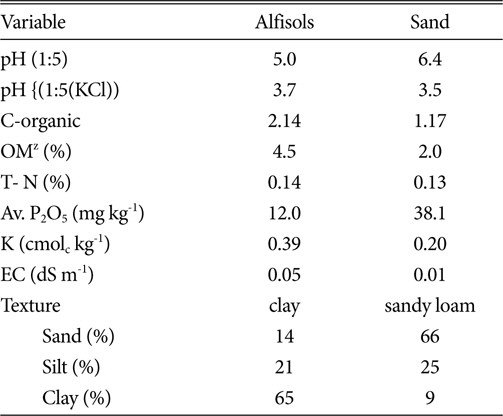
Characteristics of alfisols and volcano eruption sand used as growing media.
[Table 2.] Distribution of particle sizes of eruption sand from merapi volcano.
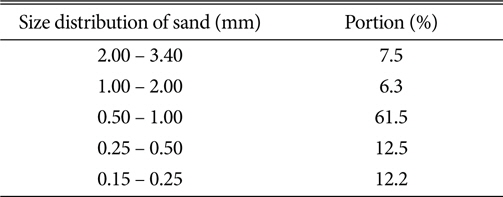
Distribution of particle sizes of eruption sand from merapi volcano.
[Table 3.] Micronutrients content of merapi mountain volcanic soil.
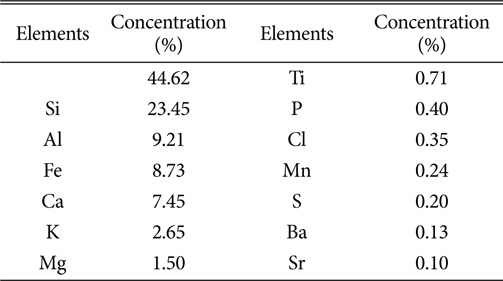
Micronutrients content of merapi mountain volcanic soil.
Zoysiagrass (
The research was conducted in January-September 2012, in the dry land and chemical Laboratory of Agriculture Faculty, Sebelas Maret University Indonesia. Rainy season covered this research period from January to April, and dry season from April to September. Research plots designed using by completely randomized design. There were 6 treatment combinations of growing media and fertilizer with 3 replicate. The growing medias were M1: pure Alfisols soil and M2: mixing of 80% sand and 20% alfisol soil volume / volume. The fertilizers were F0: without fertilizer, F1: organic fertilizer (fine compost 2712.5 gm-2 year-1), and F2: inorganic fertilizers N: P2O5: K2O ratio of 4:1:2, by mixing of urea by 84.9 g m-2 year-1, SP-36 fertilizer 42.45 g m-2 year-1; and KCl by 42.45 g m-2 year-1. Fine compost contained total N of 1.71 %, P2O5 of 1.69%, K2O of 1.86% and C /N ratio of 20%. Application of fertilizer was done before planting and followed by every 1.5 month. The thickness of growing media was 20 cm and the size of plot was 80×80 cm.
Zoysiagrass was planted by plugging with distance of 15 cm intervals. Turfgrass maintenance included handy weeding and top dressing, whereas irrigation was by 100% of evapotranspiration every three days intervals. Mowing was done every week after the soil surface was covered. Grass growth was measured by density of grass shoots, leaf texture, leaf color, percentage of surface cover, shoot dry weight, root length, root dry weight, and recovery rate. Recovery rate was measured by very short mowing and check the recovery rate of turf. Color of leaf was measured by Leaf Color Chart with score 1 to 4. Score 1 for light green-yellow 2.5 GY L.3 7.5/6, score 2 light green 2.5 GY L.4 6/6.5, score 3 for green 2.5 GY DI.3 5/6.5, and score 4 for dark green 2.5 GY DI.4 4/6. Analysis of soil characteristics included soil pH (soil and water ratio 1:5), soil organic matter content using Walkley and Black method, total N using Khjedhal method, available P using Bray I, available K using Ammonium acetate method, and electric conductivity by 1:5 of soil:water. Data was analyzed by duncan's multiple range test at 95% level of confidence.
Alfisol showed lower pH than standard sand for both zoysiagrass and seashore paspalum (Table 4). Inorganic fertilizer decreased the pH of growing media, even the effect of reducing pH was more significant in alfisol. Application of organic matter did not show, any change of pH with no fertilizer in alfisol. In Merapi sand growing media the application of organic and inorganic have no effect on soil pH. The pH KCl in alfisol was lower than sand and additional fertilizer did not effected pH KCl. Media with zoysiagrass grass has pH H2O higher than with seashore paspalum when no fertilizer applied. When fertilizers were applied, the higher pH of media with zoysiagrass than by seashore paspalum was only in alfisol. This result agreed with Whitney (1991) that treatments of several types of nitrogen source fertilizer reduced pH compared to no-nitrogen application. Long-term application of N containing fertilizers results in lowering soil pH (Belay et al., 2002).
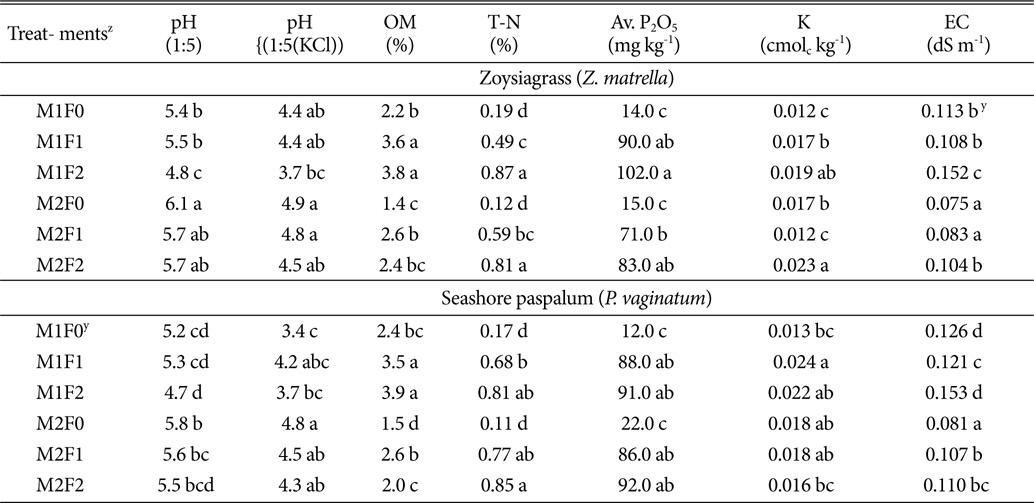
Chemical characteristics of media for zoysiagrass and seashore paspalum growing applied with different fertilizers (7 MAP).
Organic matter content of alfisol was higher than sand, especially when fertilizer was applied. Organic matter in sand is low because sand does not have soil capability to trap colloidal organic minerals, and has large pores thus its nutrients easily leached (Emmons, 2000). Organic and inorganic fertilizer increased soil organic matter content of sand and alfisol, however in sand, the increase of soil organic matter content was only by organic fertilizer. When inorganic matter fertilizer was applied, growing media of zoysiagrass was higher in soil organic matter content than the growing media for seashore paspalum.
Total nitrogen content of growing media was affected by fertilizer application, whereas type of media has no effect to the total N of growing media. Also, type of grass did not affected nitrogen content in soil. Significant difference of total N content due to different fertilizer was observed only in zoysiagrass. Availability of P in alfisol was higher than sand, and was increased by fertilizer application. Fertilizer could be the cause of decreased pH which also affect available P content in soil, when N source of fertilizer be applied in longtime. Marsh et al. (1987) reported that addition of the highest rates of N resulted in a somewhat decreased content of available P, which is probably induced by reduced solubility of Pcompounds due to increased soil acidity. Effect of the fertilizer on the soil P was similar in both growing media and also in both turfgrasses.
Fertilizing increased soil K contents, and inorganic fertilizer has higher effect than organic fertilizer. Inorganic fertilizer increased K in sand, whereas organic fertilizer increased K in alfisol. Zoysiagrass growing media showed lower K than seashore paspalum growing media when organic fertilizer was applied. Basically, lava of Merapi volcano is lime-alkaline and andesite-basaltic with high K content (Camus et al., 2000), thus potentially K nutrient is high and can be available for plant when the primary mineral weathered. Application of organic fertilizer to sand showed low K content. This result may be caused by formation of chelation that mineral K be held by organic acid. Inorganic fertilizer caused EC values increased in both growing media, but organic fertilizers did not increased the EC. FAO (2005) reported that organic fertilizer can help to lower the EC of the soil by improving soil structure and thus its percolation. When fertilizer was applied, sand media with zoysiagrass showed lower EC than with Seashore paspalum.
Shoot density of zoysiagrass was high in Alfisol with inorganic fertilizer application, whereas sand with organic fertilizer was showed low shoot density (Table 5). Shoot density of seashore paspalum was lower than zoysiagrass in both media. Report shows that, nitrogen had a highly significant influence on visual turf quality of seashore paspalum, including turf color and density that was also enhanced by the higher N rate (Trenholm et al., 2001). Inorganic fertilizer increased zoysiagrass shoot density reached more than 200 tillers / 100 cm2 compare to below 200 tillers with organic matter application. According to Beard (1973) turfgrass density more than 200 tillers / 100 cm2 was high density, lower than 100 tillers was low density, and between 100 to 200 tillers were belong to medium density.
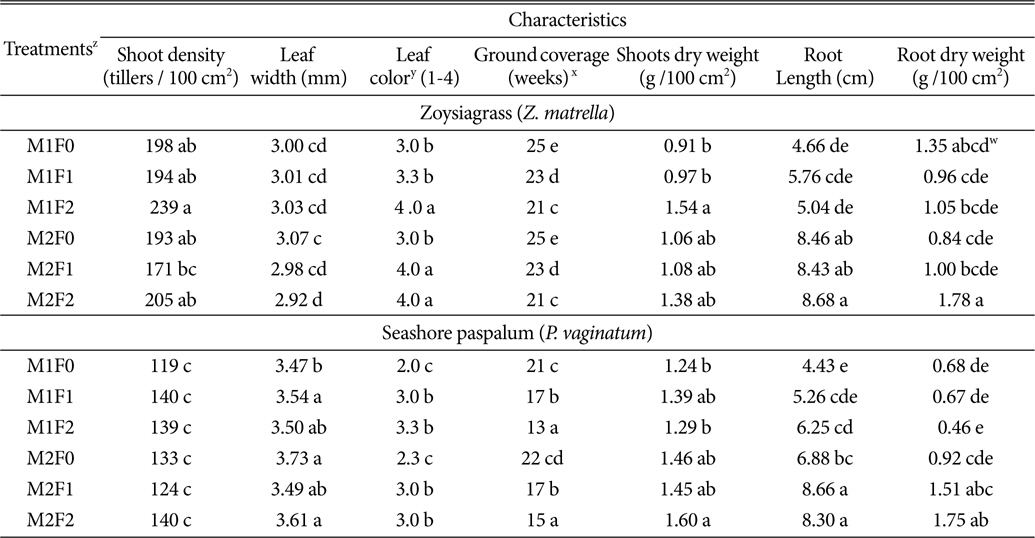
Zoysiagrass and seashore paspalum response to the growing media and different fertilizers.
Clay soil and volcanic sand did not show different shoot density of turfgrass. However, maintenance level is reported to be the most important factor for low shoot density (Emmons, 2000). Application of inorganic matter into alfisol resulted in finer texture of zoysiagrass. Zoysiagrass showed coarse texture reached up to 3mm in leaf width in sand without fertilizer. Leaf width of Indonesian native zoysiagrass showed 3.5mm, even though texture of zoysiagrass was finer than native seashore paspalum. Application of fertilizers did not affect the texture of seashoere paspalum not only in sand but also in alfisol. However, when no fertilizer applied, seashore paspalum grown in alfisol has finer in leaf texture than in sand. Shoot density increase may induce the leaf wide decrease (Emmons, 2000), and the shoot density and texture can be combined as the smoothness of the turfgrass surface (McCarty and Miller, 2002).
Fertilizers improved the color of zoysiagrass and seashore paspalum, even though inorganic fertilizer resulted in darker green color than organic in both alfisols and sand growing media. Light green does not mean low healthiness, but deficiency of nitrogen, drought, temperature stress, disease can cause in lighter color (Emmons, 2000). According to Moore et al. (1996) response of turfgrass to the nitrogen from urea application is high since the N of urea is a fast available for turfgrass grow. Trenholm et al.(2001) reported that wear tolerance, growth, and quality of seashore paspalum does response to nitrogen and potassium application.
Surface coverage rate of turfgrass is a function of stolon, rhizome and tiller growth affected by length of daytime, solar intensity and nitrogen status (Beard, 1973). Coverage rate of turfgrass was similar in sand and alfisol which increased by fertilizer application. Application of inorganic fertilizer resulted in higher coverage rate of zoysiagrass and seashore paspalum than by organic fertilizer. No fertilizer resulted in very low rate of coverage, where more than 30 weeks compared to 20 weeks by inorganic fertilizer. The ability to recover of turfgrass from damage and stress was affected by suitable condition to grow, culture technique and environment (Turgeon, 2002). Surface coverage of seashore paspalum was faster than zoysiagrass with or without fertilizer.
Most turfgrass, 60~80% of the total root length generally develops in the top 30 cm of soil (Carrow, 1996), and rooting depth increased with surface soil drying (Huang, 1999). In this study, root length was less than 10cm. When inorganic fertilizer was applied, root length and dry weight of zoysiagrass and seashore paspalum in sand growing media were longer than in alfisols. In this study, root length of zoysiagrass was similar with seashore paspalum. In sand, application of inorganic fertilizer resulted in better root development than organic fertilizer application. Seashore paspalum is able to develop roots rapidly and has large root volume (Duncan and Carrow, 2005). Beard (1982) reported that sand has good aeration especially more oxygen in root zone which have role to make root longer. Swecney et al. (2001) reported that root dry weight is important variable for plant resistance when exposed to stress condition.
This result indicated that zoysiagrass and Seashore paspalum have range of survival growth in alfisol and volcano eruption sand even without fertilizer application. Similar to zoysiagrass, recovery of seashore paspalum was increased by application of fertilizer, even the inorganic fertilizer showed faster recovery than by organic fertilizer. Applied K in clayey soil increased wear tolerance, thus increased survival of seashore paspalum (Trenholm et al., 2001).




